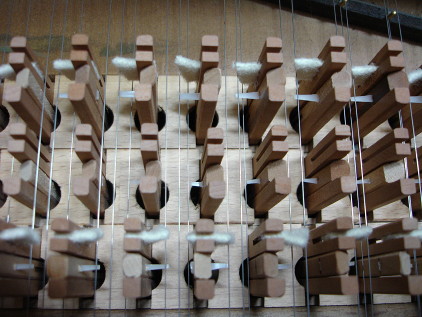Technical Library
TROPICS V: Action
Entire Contents Copyright © 2010 CBHTechnical LibraryTROPICS V: Action Entire Contents Copyright © 2010 CBH |
|
Of course, while certain areas of your soundboard can relatively easily expand and contract, your harpsichord case cannot quite change 1cm in width with humidity because of its internal bracing. But the case sides certainly expand in height, effectively dropping the whole action in relation to the stringband. Even a single millimetre here can upset the precision of a nice regulation, assuming the soundboard remains perfectly flat (which under the extremes we are talking about here, is probably not likely!).
Many makers now prepare for this by providing simple action adjustment screws under the back of the keyframe. Rather than having to adjust a tiny screw on the bottom of, say 189 jacks (as for a 63-note French Double), these keyframe adjustment screws can quickly help to restore the instrument to the tolerances of the original regulation. The adjustment here is fine, and the screws should not be cranked indiscriminately: Remove the jackrail so you can observe what you are doing. The aim is bring the 4´ quills just under their strings. If you have moved from dry to wet, you will have to turn the screws clockwise, screwing them in to raise the keyframes to compensate for the deeper, expanded case.
 CAREY BEEBE |
| Insufficient register clearance, exacerbated by high humidity Seoul, South Korea |
Registers can swell to fill the gap, rendering them too tight to move and so confining you to one registration and making tuning impossible. (This is unrelated to other structural problems which can also cause the registers to freeze). If there wasn’t enough clearance provided originally, they can be easily removed from most instruments with spine or cheek access, and planed slightly to fit.
Wooden jacks can expand and stick in the registers. There should be just sufficient clearance in the register to prevent this happening. You do not want too much slop front and back of the jack—otherwise the quill can engage the string at a different point each time, resulting in alternate weak or strong plucks and a general inconsistency of touch. Once set, or readjusted by the maker after the instrument has acclimatized, you should be right.
Wooden tongues can also swell in width, and be pinched between the top parts of the jack, but more commonly the axle hole can be found to have insufficient clearance for high humidity, and binds on the pin. Sometimes the tongue can be eased by a little vigorous exercise backwards and forwards with your fingers, but a more permanent cure is effected by punching out the axle pin and slightly easing the hole in the tongue. Tiny endodontic reamers—like your dentist uses on you for root canal therapy— are ideal for this task.
The tongue axle pins, often made of nickel-plated brass, can also corrode. The tongue must only bear on a perfectly smooth surface, so if their plating has broken down, the axle pin is probably best replaced. Without its spring, the tongue should be able to flop around unhindered on its pin. They don’t want to be too loose, though, otherwise you will find other problems.
Plastic jacks rarely give trouble, although surprizingly delrin is not inert and can misbehave in extreme environments. (Ask a mechanic who might use delrin bushes in sensitive glider applications.)
Jacks in some instruments experience problems because of corroded lead weights, much like those used in the keys. Sometimes, though, it can be verdigris coating the brass end pins, making them stick in the lower guide.
If your buff batten was a nice fit before the wet, you might find it has expanded so much that it will not budge. The pins which hold it back against the nut are now probably tight against the batten, and so adjustments will need to be made.
Often the ON and OFF positions of the registers require careful adjustment also, to bring the instrument back into regulation. If the register movement has increased, the backs of jacks could be interfering with the strings, and/or the dampers sliding right off the strings in OFF position, and then preventing the register being turned on easily. Some instruments provide capstan screw adjustments for the register positions, others are easily corrected by thin pieces of glued card. Instruments with jack screws are quite dangerous. They can be put out of regulation very quickly, with perhaps only a small screwdriver. If you don’t know what you are doing, proceed with care, or leave it completely alone and seek professional advice.
Spinets and Virginals are special cases, and climatic change will manifest itself in changes to the evenness of the action. In the harpsichord, all the jacks of a particular choir are held in the same plucking direction by the register, but the jacks for Spinets or Virginals face opposing directions. If the soundboard moves in a particular direction, you will notice every second note of the chromatic scale will be softer than its neighbour, instead of even. Some instruments offer the possibility of adjusting the side-to-side location of the register, while others are fixed and any compensation must only be made by adjusting the length of quills.
| Technical Library overview | |
| Harpsichords Australia Home Page |